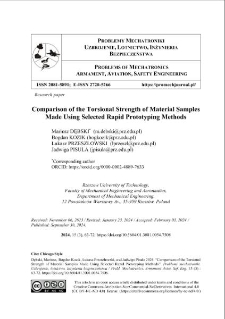Our Digital Library contains 1 868 digital objects
Object
Title: Comparison of the Torsional Strength of Material Samples Made Using Selected Rapid Prototyping Methods
Alternative title:
Contributor:
Bogdan KOZIK, Łukasz PRZESZŁOWSKI, Jadwiga PISULA
Abstract:
In recent years, there has been a marked increase in the use of rapid prototyping techniques that support industrial processes. The analysis of studies on strength tests of parts manufactured using additive techniques from model materials and hybrid composites usually includes tests of material and strength parameters based on uniaxial tension, bending, and compression tests. For elements manufactured from polymeric materials using traditional methods (e.g. injection moulding), data obtained from these tests are sufficient to determine the strength of the material and to apply the results in the product design process. In the case of the layered extrusion method, due to the model construction process, strength data based on standard samples do not have a direct transposition on the strength of machine parts operating under various load ranges, especially torsional loads. The publication presents the results of tests on the torsional strength of cylindrical samples with splines produced by layered extrusion, vacuum casting technology, and hybrid technology, which combines both technologies. The test samples were made using a Prusa i3 MK3 3D printer and the plasticised plastic modelling (fused filament fabrication, FFF) method, while PolyJet technology was used to create a reference model. The findings indicate that hybrid technology, in which a thin-walled mould is filled with a chemically hardened polymer, achieves the desired strength for the manufactured parts while maintaining dimensional accuracy and shape. The research results show that producing rotating elements using the hybrid technology reduces the sample core’s ability to undergo plastic deformation due to the adhesion between the materials and the occurrence of notches resulting from the model production process using the layered extrusion method.
Place of publishing:
Warszawa
Publisher:
Date created:
Date submitted:
Date accepted:
Date issued:
Extent:
Identifier:
oai:ribes-88.man.poznan.pl:2712
Call number:
Electronic ISSN:
Print ISSN:
Language:
License:
Rights holder:
Starting page:
Ending page:
Volume:
Journal:
Keywords:
polymer materials, torsional strength, additive technologies, hybrid technologies, vacuum casting
Object collections:
Last modified:
Oct 16, 2025
In our library since:
Oct 16, 2025
Number of object content hits:
0
All available object's versions:
https://ribes-88.man.poznan.pl/publication/3049
Show description in RDF format:
Show description in OAI-PMH format:
| Edition name | Date |
|---|---|
| Comparison of the Torsional Strength of Material Samples Made Using Selected Rapid Prototyping Methods | Oct 16, 2025 |

